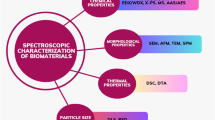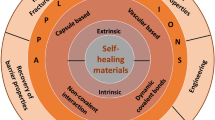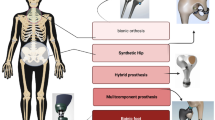Summary
In joint replacement the fixation of implants to bone is loaded dynamically. The fatique strength of the bonding of PMMA to cancellous bone was determined for cyclic tensile loading. It was found to be 35% of the static tensile strength and greater than 0.6 Nmm−2 within a 95%-safety-range.
Zusammenfassung
Die Fixation von Endoprothesen wird in vivo dynamisch beansprucht. Die Dauerfestigkeit der Verbundzone von PMMA und Spongiosa wurde bei periodischer Zugbeanspruchung in vitro bestimmt. Sie beträgt 35% der statischen Zugfestigkeit und liegt mit einer Sicherheit von 95% über 0,6 Nmm−2.
Similar content being viewed by others
Literatur
Charnley, J.: Anchorage of the femoral head prosthesis to the shaft of the femur. J. Bone Jt. Surg. 42B, 28 (1960)
Dengel, D.: Einige grundlegende Gesichtspunkte für die Planung und Auswertung von Dauerschwingversuchen. Materialprüf. 13, 145–151 (1971)
Dengel, D., Harig, H.: Zur Frage der Grenzlastspielzahl und deren Einfluß auf den Schätzwert der Dauerfestigkeit von Stahl. Materialprüf. 16, 88–94 (1974)
Kölbel, R., Boenick, U.: Mechanische Eigenschaften der Verbindung zwischen spongiösem Knochen mit Polymethylmetacrylat. 1. Zugfestigkeit. Arch. orthop. Unfall-Chir. 73, 89–97 (1972)
Kölbel, R., Boenick, U., Krieger, W., Wilk, R.: Mechanische Eigenschaften der Verbindung von spongiösem Knochen mit Polymethylmetacrylat bei statischer Belastung. 2. Scherfestigkeit. Arch. orthop. Unfall-Chir. 77, 339–347 (1973)
Kölbel, R.: Mechanische Eigenschaften einer Verbindung von spongiösem Knochen und Polymethylmetacrylat bei periodischer Belastung. Arch. orthop. Unfall-Chir. 80, 31–43 (1974)
McNeice, G. M.: Finite-element-studies of femoral endoprosteses for hip-reconstruction. ASME 1975 Biomechanics Symposium, Rensselaer Polytechnic Institute. New York: Troy (unpublished)
Scholten, R.: Über die Berechnung der mechanischen Beanspruchung in Knochenstrukturen mittels für den Flugzeugbau entwickelter Rechenverfahren. Med. Orthop. Technik 6, 130–138 (1975)
Willert, H.-G., Puls, P.: Die Reaktion des Knochens bei der Allo-Arthroplastik der Hüfte. Arch. orthop. Unfall-Chir. 72, 33–71 (1972)
Wood, R.: Ph. D-Thesis, Univ. of New South Wales, School of Mechanical and Industrial Engineering, Kensington, Australia 1975 (unpublished)
Author information
Authors and Affiliations
Additional information
Mit Unterstützung durch die Deutsche Forschungsgemeinschaft
Rights and permissions
About this article
Cite this article
Bergmann, G., Kölbel, R. & Rohlmann, A. Mechanische Eigenschaften einer Verbindung von spongiösem Knochen und Polymethylmetacrylat. Arch orthop Unfall-Chir 87, 223–233 (1977). https://doi.org/10.1007/BF00415210
Received:
Issue Date:
DOI: https://doi.org/10.1007/BF00415210




